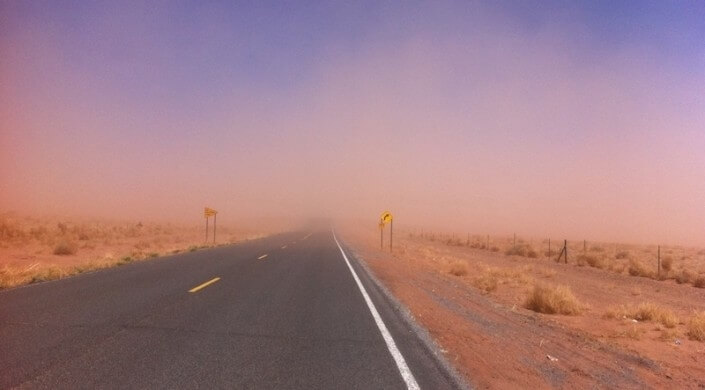News
The American southwest, already prone to high levels of dust, could see a deadly increase due to climate change by 2100.
In 1935, at the height of the Dust Bowl, a team of researchers from the Kansas Board of Health set out to understand the impact of dust on human health. In areas impacted by dust storms, the researchers documented an increase in respiratory infections, a 50-to-100 percent increase in pneumonia cases and an overall increase in “morbidity and mortality from the acute infections of the respiratory tract.”
And yet, the reported concluded on an optimistic note. After all, the researchers noted, the rain fell, the skies cleared, and it was hoped that something like this “will never occur again.”
Fast forward to 2018. Researchers from the Harvard John A. Paulson School of Engineering and Applied Sciences (SEAS), the Department of Earth and Planetary Sciences (EPS), and the George Washington University (GWU) have found that in the coming decades, increased dust emissions from severe and prolonged droughts in the American Southwest could result in significant increases in hospital admissions and premature deaths.
“Our results indicate that future droughts driven by climate change could pose a potentially substantial public health burden in the U.S. Southwest,” said Pattanun “Ploy” Achakulwisut, former Harvard graduate student and first author of the paper. “This is a climate penalty that is not yet widely recognized.”
Achakulwisut is currently a postdoctoral fellow at GWU’s Milken Institute School of Public Health.
The research is published in Environmental Research Letters.
Since the Dust Bowl, the link between exposure to airborne particles and cardiovascular and respiratory illness has been well documented but little attention has been given to how climate change may impact airborne dust levels.
This research, led by Achakulwisut, Loretta Mickley, Senior Research Fellow at SEAS, and Susan Anenberg, Associate Professor of Environmental and Occupational Health at GW, is the first to quantify how changing climatic conditions in the U.S. Southwest and northern Mexico may impact airborne dust levels and human health.
“The U.S. Southwest has been seeing some of the fastest population growth in the U.S., and the area is projected to experience severe and persistent droughts in coming decades due to human-caused climate change,” Anenberg said. “We know that droughts are associated with increases in exposure to small dust particles (PM2.5) and minerals. These pollutants can penetrate deeply into the lung and are linked to asthma, respiratory inflammation, and cardiovascular mortality, as well an illness known as Valley Fever that is on the rise in the Southwest.”
Relying on observational data of airborne fine dust levels and regional drought conditions over the past 16 years, the researchers found that years with higher-than-normal dust levels in the U.S. Southwest correspond to dry soil conditions across southwestern North America, including areas spanning the Chihuahuan, Mojave, and Sonoran Deserts. The researchers estimated future changes in dust levels associated with drought conditions under the best- and worst-case climate change scenarios, and quantified how those changes would impact human health in the surrounding areas.
They found that, depending on different climate change scenarios, airborne dust levels may increase by 10 to 30 percent. As a result, premature deaths attributable to fine dust could rise by between 20 to 130 percent, and annual hospitalizations due to dust-related cardiovascular and respiratory illness could grow by between 60 and 300 percent by 2100. These estimates take into account population growth in the region, as well as changing vulnerability to disease.
“This research highlights the need to better understand both the potential effects climate change will have on dust levels, as well as the specific health impacts of exposure to fine dust in populated, arid regions that may be vulnerable to climate change,” said Mickley. “Our results suggest that drought-driven increases in fine dust would pose a substantial public health burden in the U.S. Southwest, especially under the worst-case climate change scenario.”
This research was supported by the U.S. Environmental Protection Agency.
Topics: Climate, Environment, Health / Medicine
Cutting-edge science delivered direct to your inbox.
Join the Harvard SEAS mailing list.
Scientist Profiles
Loretta J. Mickley
Senior Research Fellow in Chemistry-Climate Interactions
Press Contact
Leah Burrows | 617-496-1351 | lburrows@seas.harvard.edu




